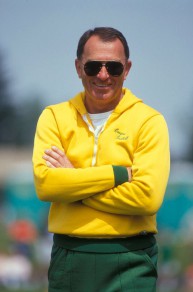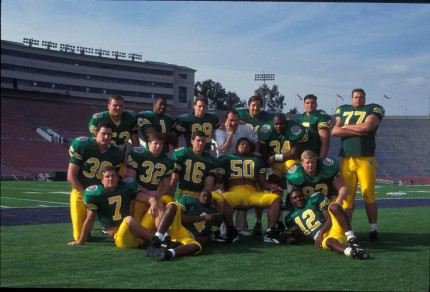
Rich!
As we move into November, the Oregon Ducks have cemented themselves as one of the elite teams in the country yet again with a huge 45-16 win over the Stanford Cardinal and their No.1-ranked total defense. However, no college football program reaches that level of success overnight.
To truly appreciate how far the Ducks have come, it is important to look back and understand who we have to thank for jump-starting an Oregon program desperately trying to get over the hump in the Pac-10 and burst onto the national scene.
For nearly 30 years, between 1965 and 1994, Oregon recorded more than six wins only twice. By the time the 1994 season rolled around, the Ducks were hungry, and it showed.
Because we are nearly at the same point in our current 2014 season as we are in our 1994 tribute series (Part 1 and Part 2), it is interesting to draw certain similarities between this year’s team and their predecessors.
In 1994, the Ducks overcame two early losses to teams that they could have beaten, and ended up winning six straight games down the stretch. This season, Oregon’s early loss to Arizona has provided a wake-up call, and the team has only looked better since.
Twenty years ago, Rich Brooks’ squad suffered a wave of injuries, placing most notably his starting quarterback and running back on the sideline for multiple games early on in the season. This year, Oregon at one point lost its top three offensive tackles to injury, and it showed in that loss to the Wildcats.
And while the nature of the two rivalries and the history behind them is certainly quite different, both teams 20 years apart have overcome their most daunting foe. In 1994 Oregon took down Washington, a team that had defeated them in 17 of the 20 prior showdowns.
This past weekend, the Ducks moved at will against an elite Stanford defense that has had their number and had held Oregon to a combined 34 points during the previous two seasons, hurling the proverbial monkey off of their backs with style.
At least in chronological terms, credit for the current state of the Oregon football program must begin with the 1994 team and its accomplishments. With wins over USC and Washington under their belts at 5-3, the Ducks were starting the beginning of a power shift in the Pac-10, but they still had a ways to go in 1994.
After beating Washington for the first time in six years, the Ducks hosted a ranked Arizona team. In what would be truly unrecognizable fashion in today’s game, Oregon held on to a 10-9 lead over the Wildcats for their third straight win to move to 6-3.
Led by linebacker Teddy Bruschi, Arizona’s superb defense held the Ducks to 3 points until the fourth quarter when senior quarterback Danny O’Neil hit tight end Justin Wilcox on a 15-yard touchdown pass on 3rd-and-long with 12 minutes left to play to give the Ducks their 10-9 lead that would become the final score.
The Gang Green defense was heroic yet again, keeping the Wildcats out of the end zone all day and shutting them out in the second half.
After two nail-biters against ranked opponents, Oregon really hit its stride during the next two weeks and took down Arizona State and Stanford with ease. The Ducks beat the Sun Devils 34-10 and flew past the Cardinal on the road 55-21.
At this point in the season, the Ducks were 8-3, and needed only a win over Oregon State to head back to the Rose Bowl for the first time in nearly 40 years. The team headed into the Civil War game ranked at No.12 in the nation, and was ready for a trip to Pasadena.
While the Beavers sat near the bottom of the conference standings with a 4-6 record, college football fans know that rivalry games can bring out the best in every team. The Ducks were in trouble heading into the fourth quarter down 13-10 on the road, and stud receiver Cristin McLemore had to be taken to the locker room with an apparent hand injury. However, the veteran playmaker returned late in the fourth quarter, and O’Neil was ready to conduct a long, game-winning drive just as he had against Washington.
Still down 13-10 with the ball in his own territory, O’Neil hit McLemore on two big pass plays to help drive the Ducks down the field. With just over three minutes to play, O’Neil dumped the ball off to running back Dino Philyaw, who had come through in the clutch already so many times that season. He sliced through the defense and into the end zone from 21 yards out to give the Ducks a 17-13 lead that they never lost.
The Gang Green defense was exceptional once again, allowing only 13 points and fending off the Beavers on the ensuing drive to seal the game. The Ducks were heading to Pasadena for the Rose Bowl for the first time in 37 years, and those two early losses were all but forgotten by Oregon fans.
Oregon’s opponent for the “Granddaddy of Them All” was Penn State, one of the elite teams in the country, led by Joe Paterno.
The Nittany Lions caught the Ducks sleeping on the first play of the game and running back Ki-Jana Carter busted a huge touchdown run to give Penn State an early 7-0 lead, and kept their foot on the gas for the entire game.
The Ducks were eventually defeated 38-20 by the exceptional Penn State squad, but the game was closer than that final score may indicate as the Ducks failed to capitalize on numerous trips deep into Nittany Lion territory.
The loss stung, but the trip to the Rose Bowl was a a victory in itself. At the beginning of the season Brooks thought he may lose his job. At the end of the season, he did lose his job, but for a good reason, as the Los Angeles Rams offered him an NFL head coaching job during their move to St. Louis.
Brooks had earned it, and he took the job, but left the program in a state of success that has yet to fade. The program has continued to flourish over the past 20 years and in the past five years the Ducks have won three conference championships, played for a national title and won a Rose Bowl game.
With the college football playoff upon us and quarterback Marcus Mariota looking as special as ever, the 2014 season may end up being the exclamation point on this wonderful era of Oregon football ignited by Brooks and the 1994 Gang Green squad.
Oregon’s culture may have changed, and the innovative Ducks may have led the charge into the future of college football, but every program has a history, and the current Oregon football program owes a lot to its 1994 predecessors.
Top Photo by John Giustina
Related Articles:
Joey Holland graduated from the University of Oregon in 2013, majoring in History. He played several sports in high school, though football remains his passion. He has yet to miss a single Oregon Ducks home football game during his time in Eugene. Joey has written previously for Bleacher Report and Football Nation.
Joey welcomes your feedback.




